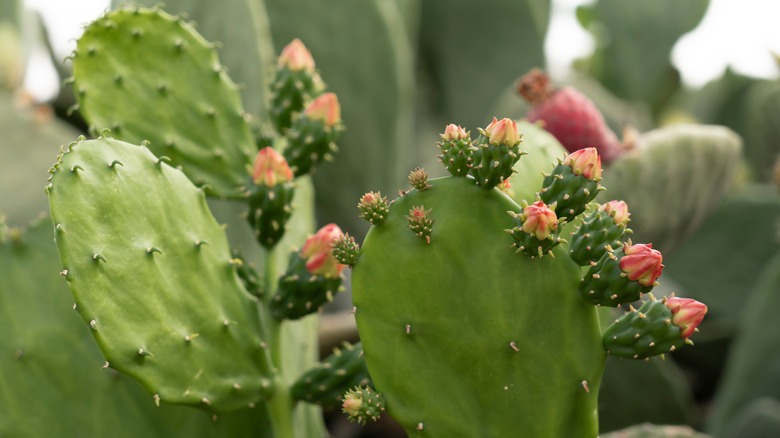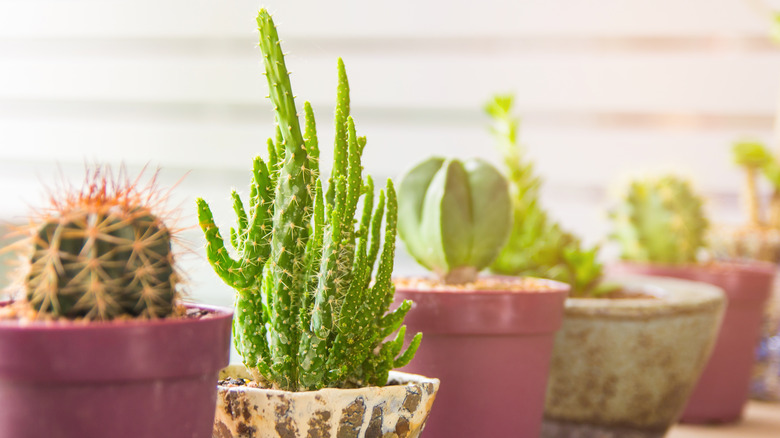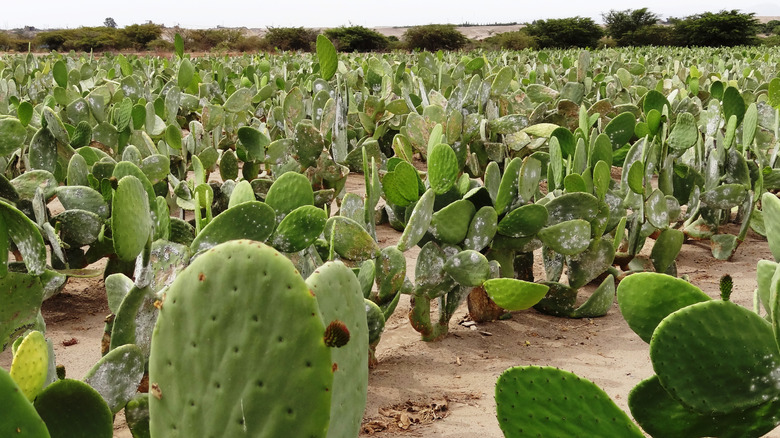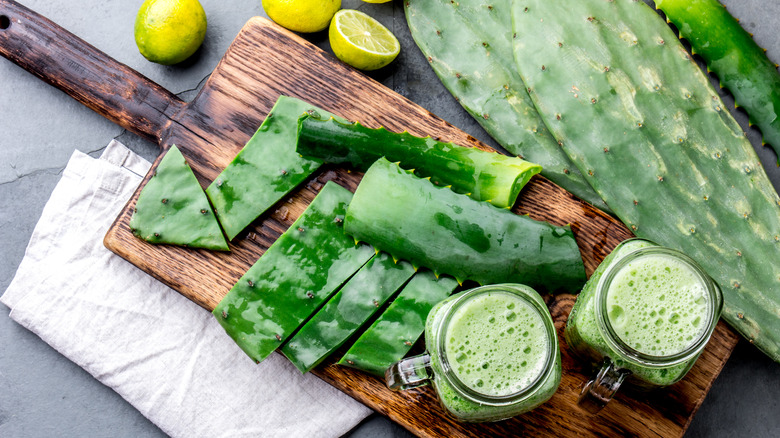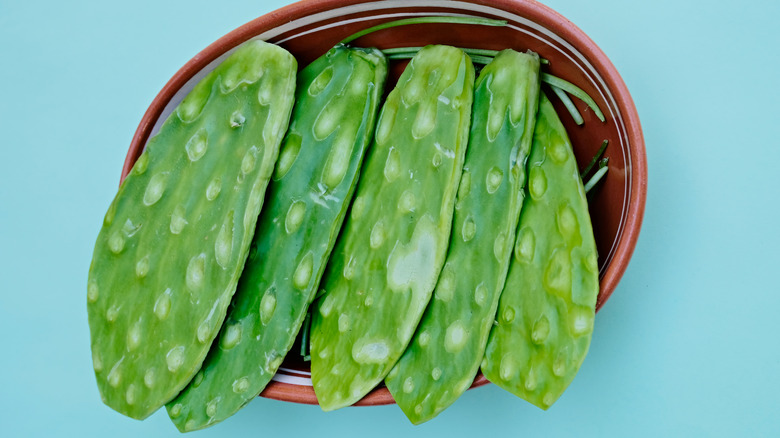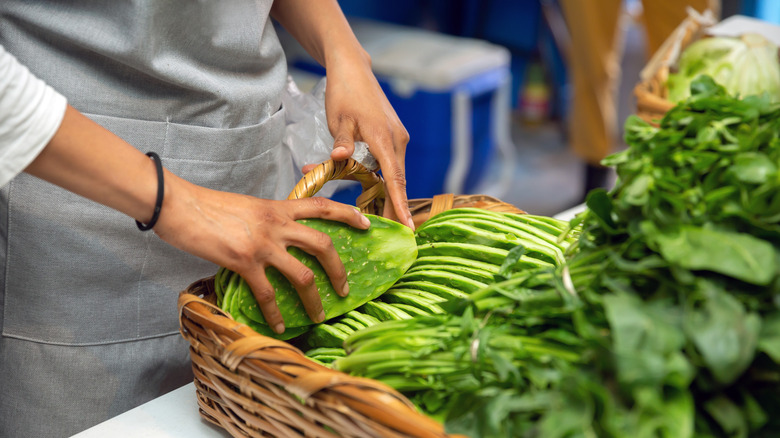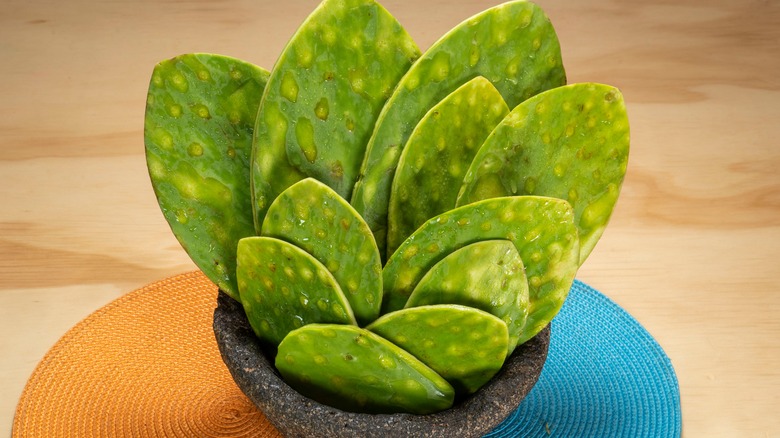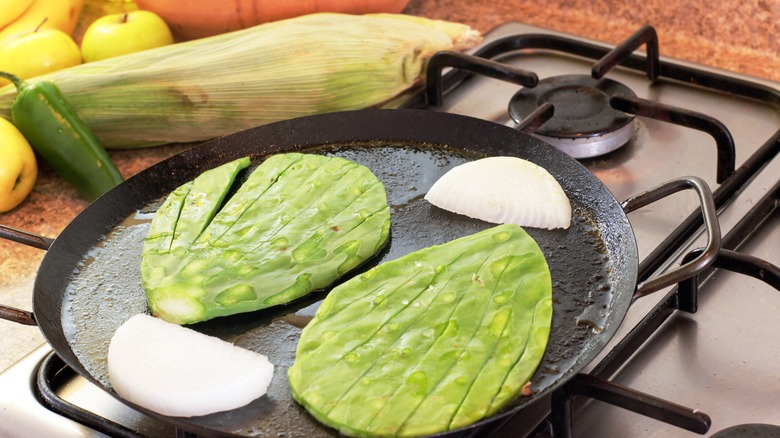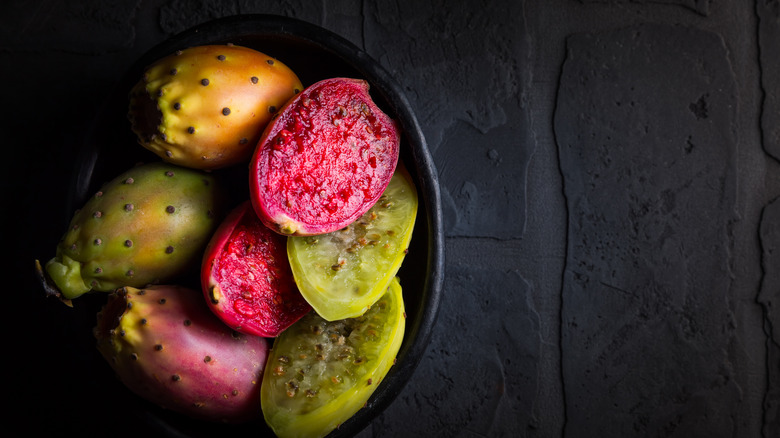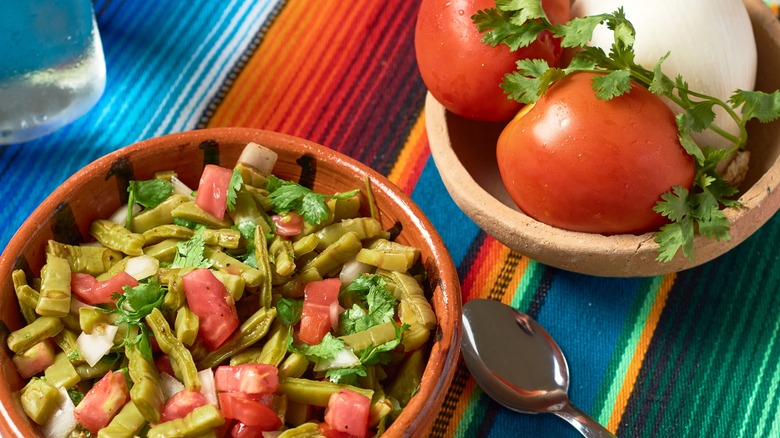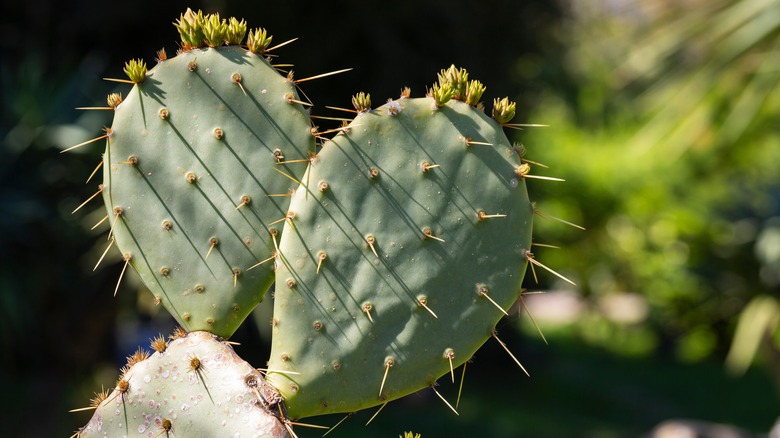A Beginner's Guide To Edible Cactus
When hearing the word "cactus," you might think of hot and dry deserts or arid landscapes with no food or water. As mindblowing as it sounds, cacti are not only a decorative plant or a desert symbol but a healthful and delicious ingredient with numerous associated health benefits. According to the Cactus Network, there are more than 1,600 cactus species worldwide. Yet, the Opuntia genus (which holds 300-plus species) includes the most common types of cacti. Cacti are incredibly versatile and important, seeing that they have a wide range of uses that go from a vegetable or fruit (depending on which part you're eating) to a forage crop, natural fence, food supplement, or even a processed food or medicinal ingredient.
A review published in the Journal of Food Science and Technology explains that cacti have evolved and adapted to thrive in harsh environments and, thus, have the potential to be the food of the future. For example, the plants' paddles are actually their stems (which hold an incredible amount of water for survival), and their characteristic spines are their version of leaves. Per the review, cacti fruit is highly nutritious, and their cooked stems make a tender vegetable fit for almost any dish. Nevertheless, not all cacti are safe to eat. This article will tell you what you need to know about edible cacti, including their health benefits, potential risks, and how to cook them.
Edible cactus varieties
According to the Cactus Network, indigenous communities in different parts of the American continent have relied on cacti for food for hundreds of years, with the Opuntia cacti (commonly known as the Prickly Pear or Nopal cactus) being the most widely consumed variety. The Prickly Pear cactus can be found throughout the southwestern United States and northern Mexico, and you can consume both its pads and fruit. Prickly Pear's pads have a bit of a slimy texture and a veggie-like flavor, while the bright red fruit is described as sweet but tart.
In addition to the Prickly Pear cactus, the National Park Service (NPS) lists eight more edible cacti, including Cane Cholla, Claret Cup, Desert Spoon, Agave Lechuguilla, New Mexico Agave, Purple Prickly Pear, Soaptree Yucca, and Torrey Yucca. However, while the Prickly Pear and New Mexico Agave cacti have multiple edible parts, people usually eat different parts of the plant depending on the cactus. For instance, you can consume the sweet and ripe fruit of the Cane Cholla, Claret Cup, and Torrey Yucca cacti. In contrast, the Purple Prickly Pear Cactus is more popular for its edible stem, while the Soaptree Yucca cactus is known for its edible flower stalks and pods.
As for Desert Spoon, Agave Lechuguilla, and New Mexico Agave cacti, they're primarily used to prepare alcoholic beverages. "Softer plant parts including the inner cluster of unopened leaves can be boiled and eaten or fermented into an alcoholic drink" (via USDA).
A sustainable food choice
Edible cacti are not only praised for their nutritional qualities and potential health benefits, but they're also valued for their highly sustainable traits. As the Food and Agriculture Organization (FAO) explains, given the increased risk of droughts in different parts of the world as a result of climate change, cacti are becoming an essential crop due to their drought-tolerant nature, which comes from their adaptation to hot, dry environments that allows them to grow with minimal water. This means they can be grown in areas where other crops might struggle due to lack of water. Furthermore, the International Center for Agricultural Research in the Dry Areas (ICARDA) adds that aside from being an easy-to-grow crop, cacti are a guaranteed source of water that can sustain livestock during dry seasons.
In addition, the FAO also states that cacti can improve soil health, saying that reports show greater Tunisian barley yields when they're cultivated one next to the other. Moreover, using cacti as livestock feed may even reduce cattle's greenhouse gas (GHG) emissions, as it helps reduce the animals' methane production. Lastly, since cacti have multiple uses beyond food and seeing that there are markets for their pads, flowers, and fruit alike, growing cacti can have benefits as a multipurpose crop that go beyond just food production (via Smithsonian Magazine). Overall, the sustainable characteristics of cacti make them an appealing food choice and income stream for areas with limited resources.
Edible cactus nutrition
Edible cactus is a low-calorie and nutrient-dense food rich in vitamins, minerals, and antioxidants. According to the U.S. Department of Agriculture (USDA), a 1-cup serving of cooked cactus (150 grams) provides just 24 calories, 5 grams of carbohydrates (of which 66% consists of dietary fiber), 2 grams of protein, and less than 1 gram of fat. Plus, it packs 19% of the daily value (DV) for calcium and magnesium, and 13% of the DV for vitamin C (which your body needs to support bone, muscle, and immune health, respectively). For reference, the Food and Drug Administration (FDA) defines the DV of a nutrient as the amount you should aim to consume per day.
Moreover, a review published in the Journal of Food Science and Technology says that, like most fruits, fruit from an edible cactus is rich in sugar, vitamins, minerals, and colorful red, orange, yellow, and purple pigments such as beta-carotene, betalains, betacyanins, and betaxanthins, which are known for their antioxidant properties (compounds that help fight the damaging effects of free radicals in your body). Yet, another review published in the journal Life reminds you to note that the overall nutrient composition of any edible cactus depends on multiple factors, including the variety or the climate of the region where it is grown.
Health benefits of edible cactus
According to a study published in the journal Oxidative Medicine and Cellular Longevity, people have used edible cacti (namely those belonging to the Opuntia species like the Prickly Pear cactus) in folk medicine for centuries to treat chronic diseases. Per the study, bioactive plant compounds and nutrients like antioxidants and fiber play key roles in the management of said conditions, which are known for leading to high inflammatory and oxidative stress levels. For example, the study points out that both nutrients grant cacti cholesterol-lowering properties and promote the reduction of plaque formation or atherosclerosis, two major risk factors for heart disease. In addition, eating cacti can help improve insulin sensitivity and manage your blood sugar levels after a meal (also known as postprandial glycemia) due to their high fiber content, which slows down the absorption and release of sugar from foods into your bloodstream.
Moreover, a 2021 study published in Plants states that antioxidants in cactus fruit may even have cancer-fighting properties. In the study, researchers found that yellow Prickly Pear cactus fruit may help prevent cancer cell growth thanks to its selective toxicity that affects only cancerous cells, although more research is still needed. Lastly, a review published in Life says that the high fiber content of cacti fruit can help with digestive issues such as constipation, as well as provide anti-inflammatory properties. At the same time, the extract may have "natural antibacterial agents against some microbes."
Where to find edible cactus
The Prickly Pear cactus is the most widely available type of edible cactus, which is consumed for both its paddles and flowers. According to the Food and Agriculture Organization (FAO), it is cultivated in numerous countries all over the world, yet its use may vary from one place to another. For example, Argentina, Chile, Eritrea, Southwestern United States, Ethiopia, Italy, Peru, South Africa, Brazil, Cuba, Egypt, India, Israel, Spain, Turkey, and Venezuela cultivate it for its fruit. In contrast, Morroco does it for its fruit and flowers (which are used for honey production).
However, per the FAO, Mexico is the country that leads the production of the Prickly Pear cactus, as well as the development of derived products, and it is the only one with a market that focuses on the commercialization of its paddles, which are locally known as nopales. You can buy nopales at any time of the year, but their peak season is in the middle of spring (via Specialty Produce). You may find fresh and locally grown nopales in local farmer markets throughout the Southwestern United States, as well as in some specialty food stores (particularly those that focus on Mexican or Southwestern cuisine), which may offer canned or pickled varieties. Lastly, you may find edible cacti for sale from online retailers. If you're looking for cactus fruit, they are typically available in the United States from the middle of summer until the fall season (via Food Print).
What to look for when buying edible cactus
Whether you're getting your edible cactus or nopal from a grocery store or local farmer's market, there are a couple of things you should look for (or avoid) when making a purchase. For starters, aim for a fresh-looking cactus that's free of bruises, overly-soft spots, or signs of mold. Fresh cactus paddles should have a soft yet firm texture (this one also applies to the fruit) and a bright green color (via Food Print). They should also be properly cleaned and free of any dirt or debris. Moreover, the site explains that some farmers may use synthetic fertilizers and pesticides to grow their cacti. Thus, if you are concerned about pesticides or other chemicals, look for edible cactus that is certified organic or non-GMO.
Since cactus spines are not edible, they must be removed beforehand (which can be a hassle or even a dangerous or painful ordeal). Therefore, it is best to make sure the cactus has been properly cleaned and trimmed of any spines or prickly parts (per Specialty Produce). Also, choose cactus pads or fruits with a good size and shape for your intended use. Lastly, try to buy edible cacti from a reputable source, such as a local farmer or a trusted online retailer, and make sure the cactus has been grown and harvested in a sustainable and environmentally friendly manner.
How to cook cactus
Prickly pear paddles or nopales can be cooked in many different ways, including boiling and grilling, but they have to be de-spined first. You can use a knife to remove the spines from your paddles first by scraping the surface away from you and a vegetable peeler or harsh brush to remove any thorns or nodes that may still be sticking out, as these are where new spines would grow (via MexConnect). You can use protective gloves or a kitchen towel and prongs when de-spining nopales for safety.
While some people like to add raw nopales to salads or tacos, the site explains that cooking them helps remove their slimy sap. One easy way to cook them is by simply boiling them for about 15 minutes (just remember to dice, slice, or cut them into your preferred shape beforehand, as small pieces boil faster than a whole paddle). Another common way to cook nopales is by grilling them. In fact, grilled nopales are a staple in Mexican barbecues. To grill nopales, it is customary to cut or peel their borders first to remove the nodes around the edges. Then, simply brush them with olive oil, season them with salt and pepper, and grill them until they look slightly charred and soft. Other ways to cook nopales include frying, pickling, dehydrating, or sautéing them. You can store any extra nopales in a sealed container in the refrigerator for up to two weeks.
Cooking cactus fruit
Cactus fruit (also known as prickly pear or cactus pear) is an oval-shaped fruit with a color that typically ranges from bright green to reddish-purple or burgundy. It has a spiky and tough exterior but is relatively soft and grainy on the inside, and it has countless tiny edible seeds (via Martha Stewart). This juicy fruit is known for its unique and refreshing flavor, which is often described as a cross between watermelon and bubblegum. It is sweet with a subtle tartness and a hint of cucumber-like freshness.
Prickly pear is a delicious and versatile fruit that can be used in a variety of sweet and savory dishes. Yet, like cactus paddles or nopales, you have to remove the fruit's thorns before eating or cooking it. To do so, brush them thoroughly until all the pointy ends are off (and don't forget to wear protective gloves!). Once you've cleaned the fruit, you can easily peel it by slicing both ends and making a cut from one end to the other. Then, you can simply peel the fruit by pulling the skin back with your hands. Alternatively, you can just cut the fruit in half after cutting off the ends. While you can eat fresh prickly pear fruit by simply dicing it into small pieces, other common ways to enjoy it include extracting its juice, adding it to smoothies, or making prickly pear-based desserts, jams, jellies, syrup, candy, vinaigrette, sauce, and wine.
Best pairings when serving cactus
Adding cactus paddles or nopales to your menu is simpler than you think due to their incredible versatility. Given their vegetable-like texture and mild flavor, they pair nicely with animal-based proteins such as eggs, poultry, beef, and cheese, and spices such as chile, oregano, cilantro, and lemon. You can also mix them with other vegetables — tomatoes, onions, avocados, and bell peppers come to mind. And since they're a staple in Mexican cuisine, you can't forget to pair them with corn tortillas and salsa.
One of the easiest ways to serve cacti is by incorporating them directly into your dishes. For example, you can add them to omelets or scrambled eggs for breakfast, mix them with ground meat or chorizo, toss them into a fresh green salad and dress with a vinaigrette or lime juice, serve them on top of meat or fish tacos or ceviche, or stir them into your soup. In addition, the slightly tart and crunchy texture of grilled or fried nopales in the form of french fries can provide a nice contrast to the richness of grilled meats. Thus, they make a great side vegetable for steak, chicken, shrimp, portobello mushrooms, or cauliflower steaks. Lastly, you can serve chicken and steak with prickly pear sauce or gravy, as well as any nopal-based dish with a glass of prickly pear juice.
Potential risks of eating cactus
One of the greatest and most obvious risks of eating cacti is definitely having to deal with their sharp spines and thorns. Aside from having the potential to injure you while handling them, they could also lead to Mechanical Irritant Contact Dermatitis (MICD), the most frequent skin condition caused by plants, according to a study published in the journal Dermatitis. Per the study, aside from the bigger and more noticeable spines, prickly pear cacti and fruit also have smaller, detachable, irritant spines known as glochids, which can cause cactus-induced MICD reactions. This skin rash can look similar to scabies and is commonly known as "sabra dermatitis." Moreover, glochids can be easily transferred to your clothes, which increases the risk of reaching and injuring other parts of your body. In addition, accidentally consuming them can lead to eruptions in your oral mucosa and hard palate.
Additionally, the Mayo Clinic states that consuming too much prickly pear cactus at a time can cause digestive issues or mild side effects like nausea, diarrhea or more frequent bowel movements, and larger-sized stools. Thus, it would be best to incorporate it in small batches when first adding it to your menu. Finally, keep in mind that not all cacti are edible, and some have high amounts of natural compounds that can harm your kidneys or cause other symptoms, such as diarrhea and vomiting (per the Encyclopedia Britannica). Overall, as long as you take proper precautions and consume cactus in moderation, it can be a healthy and flavorful addition to your diet.
